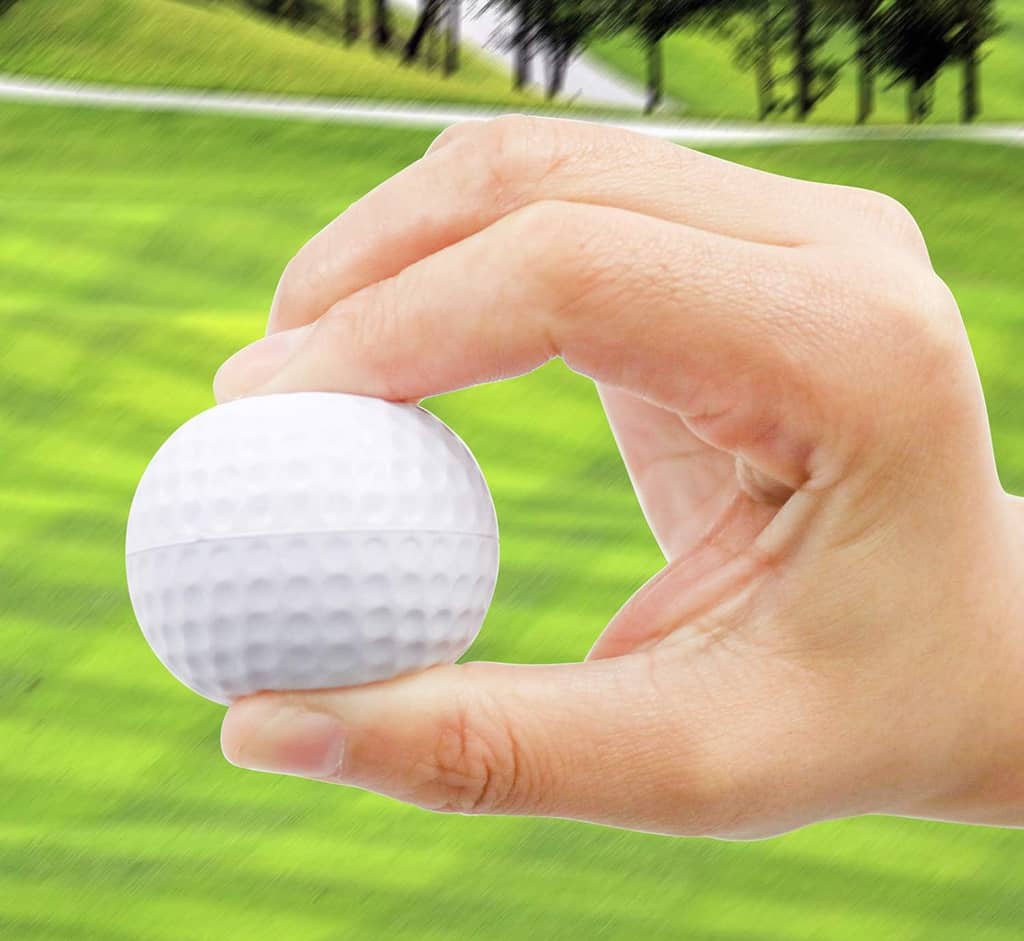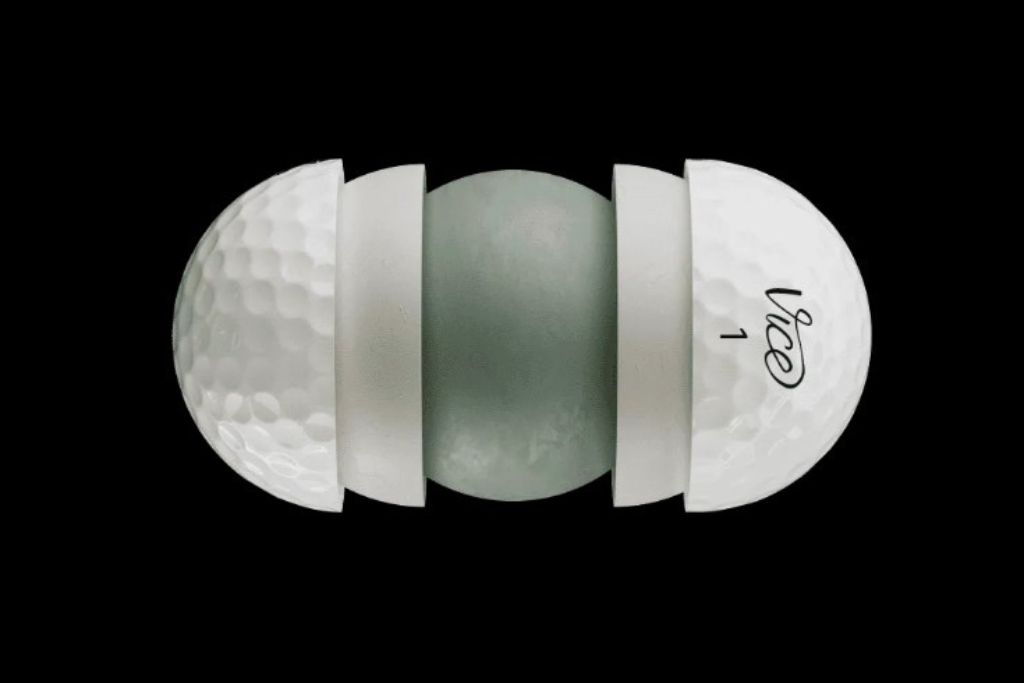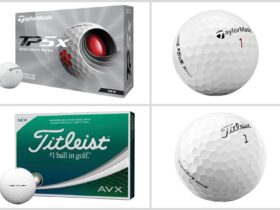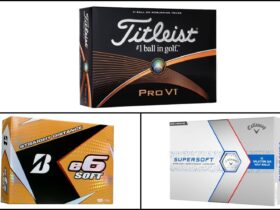A golf ball compression chart categorizes balls by their compression rating. Lower ratings suggest softer balls, while higher values indicate firmer golf balls.
Understanding the golf ball compression chart is crucial for golfers aiming to optimize their game. Compression measures how much a golf ball deflects when struck, impacting distance, control, and feel. A proper match between a golfer’s swing speed and the ball’s compression can lead to improved performance.
Golfers with slower swing speeds tend to benefit from lower compression balls, which can help maximize distance. Conversely, players with faster swings may prefer higher compression balls for better control. Choosing the right golf ball compression chart can significantly affect a golfer’s experience on the course. The compression chart serves as a guide to help players select a ball that complements their playing style and swing characteristics.
Introduction To Golf Ball Compression

Welcome to the golf ball compression chart, where every detail can impact your game. A golf ball compression chart may seem technical, but it’s crucial for players of all levels. This post will introduce you to the concept and explain why it matters for your performance.
Importance In-Game Performance
Understanding the golf ball compression chart is vital for every golfer. It affects how the ball reacts upon impact. The right compression can mean longer drives and more control. A mismatch can hinder your game.
- Low-compression balls work best for slower swings.
- High-compression balls favor players with faster swings.
Choosing the correct compression can lead to better shot accuracy and improved overall scores.
Basic Concepts
golf ball compression chart measures the ball’s hardness. The scale typically runs from low (65-80) to high (100+). This number reflects how much the ball deforms at impact.
| Compression Rating | Suitable for Swing Speed |
| 65-80 | Slower Swing Speeds |
| 80-90 | Moderate Swing Speeds |
| 90-100 | Faster Swing Speeds |
| 100+ | Very Fast Swing Speeds |
Select a ball with a compression rating that matches your swing speed. Your game will benefit greatly from this alignment.
History Of Golf Ball Design
The journey of the golf ball compression chart is a tale of innovation and transformation. Over centuries, its design has evolved, adapting to new materials and technologies. This evolution has profoundly impacted how players approach the game. Let’s explore the origins and advancements that have shaped the modern golf ball.
Early Materials And Designs
In the beginning, golf balls were simple. Crafted from hardwood like beech or boxwood, they were tough but didn’t travel far. By the 17th century, the feathery ball emerged.
This was a leather pouch stuffed with bird feathers. While they flew farther, they were expensive and difficult to make.
The 19th century brought the gutter ball, made from gutta-percha resin. Manufacturers produced these balls more cheaply, and players could easily reshape them when they became too rough. Here’s how the early golf ball compression chart differed:
| Ball Type | Material | Pros | Cons |
| Wooden | Hardwood | Durable | Short flight |
| Feathery | Leather and feathers | Longer flight | Expensive |
| Guttie | Gutta-percha resin | Cheap, reshaped easily | Less durable |
Technological Advancements
The 20th century was a game-changer for golf balls. Rubber-core balls, or wound balls, became the standard. They offered better flight and durability.
The introduction of Dimples in the early 1900s was revolutionary. Dimples reduced air resistance and increased lift, allowing balls to travel further and more accurately.
Today’s golf balls are a product of high-tech engineering. Manufacturers use sophisticated materials and designs to cater to different play styles. Here’s a glance at the tech used:
- Multi-layer construction for varied spin and velocity
- Urethane covers for control and feel
- Advanced dimple patterns for flight
Each innovation has led to the diverse range of golf balls we see today. Beginners use soft, low-compression balls, while professionals use hard, high-compression balls. There’s a ball for every player. Understanding the golf ball compression chart can help golfers choose the right ball to improve their game.
What Is Golf Ball Compression?

Understanding the golf ball compression chart is key for any golfer. It refers to how much a golf ball deforms under impact. This deformation affects the ball’s performance, including its speed, distance, and feel. Manufacturers design golf balls with different compression ratings to suit various playing styles and swing speeds.
Compression Ratings Explained
Golf ball compression chart ratings usually range from 30 to 100. These numbers tell us how soft or hard a ball is:
- Low compression (30-50) – Softer feel, more deformation, better for slower swings.
- Medium compression (51-80) – A balance of softness and firm feel, suitable for most players.
- High compression (81-100) – Less deformation, firmer feel, great for fast swingers.
Choosing the right golf ball compression chart helps maximize the performance and enjoyment of the game.
Impact On Ball Flight
The compression of a golf ball greatly influences its flight in the air. Here’s how:
- Lower compression – This leads to higher ball flight and more spin.
- Higher compression – Results in lower trajectory and less spin.
Understanding these effects can help golfers choose the right ball to fit their game style and conditions.
Types Of Golf Ball Compression Chart
Understanding the golf ball compression chart is key to choosing the right ball. It affects distance, feel, and performance. Golf balls come in different compressions suited for various play styles. Let’s dive into the types of golf balls by compression.
Low Compression Balls
Designed for players with slower swing speeds, low-compression golf balls offer a softer feel. They compress more easily on impact, which can lead to greater distance for those with gentler swings.
- Great for beginners and seniors
- Typically have a compression rating of 80 or less
- Enhance overall playability for slower swings
High Compression Balls
High-compression balls suit players with fast swings. They require more force to compress and can travel farther when struck correctly. High compression typically equates to a rating above 90.
- Ideal for golfers with high swing speeds
- Offer more control for experienced players
- Provide a firmer feel and more precise feedback
How Compression Affects Gameplay
A golf ball compression chart can make a big impact on your game. It affects how the ball reacts when struck by a club. Different compression rates suit different playing styles and skill levels. Understanding this can help golfers choose the right ball for their game.
Benefits For High Handicappers
Lower compression balls are often best for high handicappers. Here’s why:
- More Forgiveness: They are softer and deform more on impact. This results in fewer slices and hooks.
- Better Control: These balls allow for more control, helping high handicappers keep their shots on the fairway.
- Enhanced Distance: They require less force to compress, making it easier to achieve longer distances off the tee.
Advantages For Experienced Players
High-compression balls are the choice for experienced players. The benefits include:
- Greater Energy Transfer: A firmer ball converts more swing speed into distance.
- Improved Feel: These balls offer a better sensation on impact, crucial for precise shots.
- Optimized Spin Control: They provide experienced players with the ability to shape shots and control spin more effectively.
Measuring Golf Ball Compression
Understanding the golf ball compression chart can help players choose the right ball for their game. Compression measures how much a golf ball deflects when struck. It affects the ball’s feel and distance.
Players with faster swings often prefer a high-compression ball for better control. Golf ball compression chart with slower swing may benefit from low-compression balls for more distance.
Tools And Techniques
Tools and techniques can accurately measure golf ball compression charts. Professional devices like compression testers provide precise readings. These machines of golf ball compression chart apply a force to the ball, measuring its deformation. Some popular tools include:
- Gauge Design Compression Testers
- Universal Compression Testers
- Electronic Compression Measurement Devices
Each tool has a unique way of measuring. Golfers should select the one that suits their needs.
Diy Measurement Methods
For golfers interested in a DIY approach, there are simple methods to estimate compression. One popular method involves a vice and a scale. Here’s a step-by-step guide:
- Place the golf ball in a vice.
- Tighten the vice until the ball deforms.
- Use a scale to measure the force applied.
While this won’t give as precise a result as professional tools, it offers a good estimate. Another DIY method uses a high-speed camera to capture the ball’s deformation on impact. Golfers can analyze the footage to see the ball’s compression.
Table of Contents
Choosing The Right Compression For Your Swing
Choosing the right golf ball compression chart is crucial to optimizing your game. Think of compression as the ‘feel’ factor that can affect distance and control. The right compression makes the ball react properly to your swing, ensuring peak performance. Let’s dive into how you can select the best compression to match your unique swing style.
Swing Speed Vs. Compression
Golf balls come in various compression ratings, which indicate their hardness. A high-compression ball is harder and requires a faster swing to compress it. Conversely, a low compression ball is softer and suits players with slower swings. Here’s a simple way to understand the relationship between a golf ball compression chart and swing speed:
- Fast Swing Speed: Opt for high compression balls (90+ rating).
- Moderate Swing Speed: Medium compression balls (80-89 rating) are ideal.
- Slow Swing Speed: Low compression balls (below 80 rating) work best.
Personalizing Your Golf Ball Choice
Personalization is key to enhancing your golf experience. Your choice should not only depend on swing speed but also on your playing style and what you want from the ball:
| Swing Speed | Desired Outcome | Suggested Compression |
| Fast | Control & Distance | High Compression |
| Moderate | Balanced Performance | Medium Compression |
| Slow | Soft Feel & Improved Distance | Low Compression |
Remember to test different balls on the course. Real-world experience trumps any chart. Your feel for the ball and observation of how it reacts to your shots is invaluable. Trust your instincts and make the choice that feels right for your game.
Popular Golf Ball Brands And Their Compressions
Understanding the golf ball compression chart is key for every golfer. Different brands offer various compression levels. These levels affect distance and feel. Let’s dive into popular brands and their specific compressions.
Titleist Models
Titleist stands out in the golf world. Their golf balls cater to all players. Let’s look at some Titleist models and their compression ratings:
- Titleist Pro V1: High performance, around 90 compression.
- Titleist Pro V1x: Slightly firmer, about 100 compression.
- Titleist AVX: Lower compression, close to 80, softer feel.
- Titleist Tour Soft: Softest option, compression near 65.
- Titleist Velocity: Designed for distance, compression of 75.
Callaway Options
Callaway offers diverse golf balls. They suit many playing styles. Below are Callaway balls with their golf ball compression chart ratings:
| Model | Compression |
| Callaway Chrome Soft | Soft, around 75 |
| Callaway Chrome Soft X | Firmer, roughly 90 |
| Callaway Supersoft | Very low, close to 38 |
| Callaway Warbird | Higher compression, near 90 |
| Callaway ERC Soft | Medium compression, about 60 |
Golf Ball Compression And Weather Conditions

The golf ball compression chart matters a lot in golf. Compression means how much the ball squishes against the club. The weather can change how the ball flies. Let’s see how different weather affects golf ball compression.
Effects Of Cold Weather
In cold weather, golf balls don’t squish as much. This means they don’t travel as far. Your swing might feel harder, and the ball might feel like a rock. Keep this in mind:
- Use a ball with lower compression in the cold.
- These balls can help you hit it further.
- Keep the balls warm before playing. Try keeping them in your pocket.
Warm Weather Performance
When it’s warm, balls squish more and go further. Warm air is less dense, so the ball cuts through it easier. Here’s what to remember:
- Choose a higher compression ball for warm weather.
- These balls give better control and spin.
- Store balls in a cool place so they don’t get too soft.
Age And Compression: Do Golf Balls Lose Elasticity?
As golf balls age, they may lose their bounce and feel. This change affects how they perform on the course.The golf ball compression chart plays a crucial role in its performance.
It determines how the ball reacts when struck by a club. Extreme conditions can wear down a golf ball over time, reducing its elasticity.
Lifespan Of A Golf Ball
While designed to withstand many rounds of play, golf balls don’t last forever. The average lifespan of a golf ball can vary based on several factors:
- Frequency of play
- Storage conditions
- Exposure to harsh environments
A typical golf ball can last anywhere from five to seven years if stored properly and not lost on the course first!
Storage Tips To Preserve Compression
Proper storage is key to maintaining your golf balls’ performance. Here are some tips to help keep your golf balls in top condition:
- Avoid extreme temperatures: Store your golf balls in a moderate, stable environment.
- Keep them dry: Moisture can damage the outer layer and core of golf balls.
- Use proper containers: Storing golf balls in a bag or container that limits their exposure to weight and pressure helps them maintain their shape and compression.
Following these simple storage tips will help ensure that your golf balls retain their integrity and performance for each game.
Compression Ratings And Professional Tours
Golf ball compression chart ratings play a vital role in a player’s performance. They influence the ball’s feel and distance.
Pro golfers choose their balls with precision. Each tour sets its equipment standards. This affects what compression ratings pros can use.
What Professionals Use?
Top golfers pick balls that fit their play style. Golf ball compression chart ratings affect the ball’s reaction to impact. Players with fast swing speeds typically favor high-compression balls rated 90 and above.
They need a firmer ball to achieve optimal distance and control. Lower compression balls, rated below 90, suit players with slower swing speeds. They provide a better feel and help with distance.
- Tiger Woods often plays with a high-compression ball.
- Phil Mickelson might choose a lower compression ball for better control around the greens.
Tournament Regulations
Major tournaments have strict equipment regulations. The USGA and RA set rules on ball performance. These rules ensure fair play. Golf balls must pass compression tests for use in tournaments.
| Tournament | Compression Range |
| PGA Tour | Varies |
| European Tour | Varies |
| LPGA | Varies |
| Masters | Varies |
All professional golfers must adhere to these regulations. They choose their golf balls accordingly. This ensures a level playing field for all competitors.
Misconceptions About Golf Ball Compression
Golf ball compression chart can be a puzzling topic for many games. The term relates to the hardness of a golf ball and how it impacts play. Various myths surround this concept, leading to confusion. Let’s debunk these myths and separate fact from fiction.
Common Myths Debunked
- Myth: Higher compression balls are for pros only.
- Fact: Skill level does not restrict ball type. It’s about swing speed and feel preference.
- Myth: Low-compression balls can’t achieve long distances.
- Fact: They can travel far, especially if matched with the right swing speed.
- Myth: Compression doesn’t affect performance.
- Fact: It does! The right compression can improve control and distance.
Facts Vs. Fiction
| Fiction | Fact |
| Only high-compression balls offer a professional feel. | The feel is subjective and can come from any compression level. |
| Compression ratings are consistent across all brands. | Each brand may measure differently, so ratings can vary. |
| Choosing a ball solely based on compression ensures better play. | Consider other factors like construction, dimple design, and personal preference. |
Influence of Golf Ball Layers on Compression
Understanding how golf ball layers affect compression can improve your game. Different layers in a ball change how it feels and flies. Let’s explore two main types: two-piece balls and multi-layer constructions.
Two-piece Balls
Two-piece golf balls are simple but effective. They have a core and a cover. The core is usually hard and made of rubber.
The cover is softer, often made of Surlyn. This design leads to:
- Lower compression: Easier to hit farther.
- Less spin: More control on long shots.
This type is great for beginners. It helps with long distances even with slower swings.
Multi-layer Constructions
Multi-layer golf balls have three or more layers. These include a core, mantle(s), and a soft cover. This setup allows for:
- Higher compression: Better for experienced players.
- More spin control: Offers precision around the green.
These balls suit players with faster swing speeds. They help in fine-tuning shot-making skills.
Choosing the right ball involves knowing your play style. Pick a ball that matches how you play and the speed of your swing.
Impact Of Compression On Spin Rates
The relationship between the golf ball compression chart and spin rates is a critical aspect of golf science. Compression affects how much a ball deforms at impact. This in turn influences the spin. Understanding this can help golfers choose the right ball.
Reducing Spin with High Compression
High-compression golf balls are typically harder. They deform less when struck. This leads to a reduction in backspin.
Golfers with high swing speeds benefit the most. They can achieve longer distances with a more penetrating ball flight.
- Designed for faster swing speeds
- Less deformation on impact
- Lower spin rates
Increasing Spin with Low Compression
Low-compression balls are softer. They deform more upon impact. This increases the backspin.
Golfers with slower swing speeds find these balls easier to control. They provide better greenside control and a softer feel.
- Great for slower swing speeds
- More deformation leads to more spin
- Improved control around the greens
Matching Compression With Golf Clubs
The golf ball compression chart matters when choosing the right golf ball for your game. Matching the golf ball compression chart with the correct club can enhance your performance on the course. Let’s explore how to pair these two crucial aspects of golf.
Best Balls For Drivers
Drivers demand low-compression balls for better distance. These balls compress easily on impact. This results in a greater energy transfer from the club to the ball, maximizing distance off the tee.
- Titleist Pro V1: High-performance and low compression
- Callaway Supersoft: Designed for increased speed and low spin
- TaylorMade Soft Response: Soft feel with a durable, low-compression core
Ideal Choices For Irons And Wedges
With irons and wedges, mid to high-compression balls are ideal. They provide better control and a softer feel around the greens.
| Club Type | Golf Ball Compression | Recommended Ball |
| Irons | Medium | Bridgestone Tour B X |
| Wedges | High | Srixon Z-Star XV |
Choose the right ball for your iron and wedge shots to improve accuracy and control.
Compression And Putting Performance
Golfers know that every shot counts, and that’s true for putting too. Compression and putting performance go hand-in-hand. The right golf ball can change your game on the greens. Let’s dive into how different compressions can affect your putting.
Soft Vs. Firm Balls On The Green
Choosing between soft and firm golf balls is crucial for putting. Softballs offer a gentle feel and may help with control. Firm balls react differently.
They roll faster and can be less forgiving. Your putting style might favor one over the other.
- Softballs: better for slow, smooth strokes
- Firm balls: suit fast, confident strokes
Putting Accuracy
Accuracy on the green is essential. A golf ball compression chart can influence this. High-compression balls might be harder to control. Low-compression balls can offer better accuracy for some players.
Let’s look at a comparison:
| Compression Rating | Ball Type | Putting Accuracy |
| High (>90) | Firm | Less Control |
| Low (<90) | Soft | More Control |
Remember, the right ball for you depends on your putting style. Test different compressions to find your perfect match.
Case Studies: Improvements From Compression Changes
Choosing the right golf ball can make a big difference in your game. Golf ball compression chart rates can affect distance, control, and feel. We’ve gathered real-life examples from golfers who saw improvements after changing ball compression. Let’s dive into these case studies and see how compression changes can impact performance.
Amateur Golfer Experiences
Amateur golfers often overlook the importance of ball compression. Yet, making the right choice can lead to notable improvements. Here are some experiences:
- John Doe, a mid-handicapper, switched to a lower compression ball. His drive distance increased by 20 yards.
- Emily Smith found that a higher compression ball improved her control of the greens. She reduced her putting strokes by an average of two per round.
These cases show that amateurs can benefit from compression changes tailored to their game.
Professional Feedback
Even pros pay close attention to the golf ball compression chart. Here’s what they have to say:
| Player | Compression Change | Result |
| Alex Johnson | From High to Medium | Improved shot-shaping ability |
| Sarah Lee | From Low to High | Better wind resistance and more control |
These professionals noticed a significant impact on their game after making compression adjustments.
Golf Ball Compression In Practice Drills
Understanding golf ball compression charts can transform your game. It’s not just about hitting the ball. It’s about feeling the ball. Let’s dive into how you can practice and test golf ball compression during your drills.
Exercises For Sensing Compression
Feeling the squeeze of the ball against the clubface is key. Here are exercises to help:
- Half-Swing Punch Shots: Use a short iron. Focus on a firm, controlled impact.
- Slow-Motion Swings: Perform your swing in slow motion. Notice the compression moment.
- Barefoot Practice: Removing shoes can heighten your sense of ground force and compression.
These drills build your awareness of how the ball compresses. You will learn to control your swings better.
Testing Different Balls
Choosing the right golf ball compression chart is crucial. Compression varies from ball to ball. Test to find your perfect match.
- Record Your Findings: Note how each ball feels and performs.
- Compare Distances: Check the distance each ball travels.
- Assess the Spin: Observe the spin and control you have with each ball.
Use a chart to track the performance. This will help you pick the best ball for your game.
| Ball Type | Feel | Distance | Spin |
| Low Compression | Soft | Shorter | Higher |
| Medium Compression | Medium | Moderate | Medium |
| High Compression | Firm | Longer | Lower |
Remember to test in similar conditions for accurate results. Your ideal ball will improve your game greatly.
Future Trends In Golf Ball Compression Technology

The realm of golf is always evolving, and the technology behind the golf ball compression chart is no exception. As players seek better performance, manufacturers strive to innovate. Golf ball compression affects distance, control, and feel. Understanding future trends in this technology is crucial for every golfer aiming to enhance their game.
Innovations On The Horizon
Groundbreaking advances are transforming golf ball technology. Researchers are experimenting with new materials and designs to maximize performance. These innovations could lead to golf balls that offer more precision and longer distances for players of all skill levels.
- Smart materials that adjust to temperature changes for consistent performance.
- Micro-dimple designs to enhance flights and reduce drag.
- Nano-tech layers for improved energy transfer and durability.
Predictions For Coming Years
The future of golf ball compression is vibrant with possibilities. Here are some predictions:
- Golf balls will be more adaptive to individual play styles.
- Environmentally friendly options will become standard.
- Integration of data analytics for personalized ball selection.
These trends will not only boost player performance but also enhance the overall golfing experience. Golfers can anticipate a new era where technology meets tradition, optimizing every shot for success.
How To Read And Use Compression Charts Effectively
Understanding how to read and use a golf ball compression chart can greatly improve your game. These charts help you choose the right golf ball for your playing style.
Understanding Chart Indicators
A golf ball compression chart displays various ball ratings. These ratings indicate how much a ball will compress against a club. A lower number means softer compression; higher numbers mean harder compression. This affects how far and fast the ball travels.
Key components of these charts include:
- Compression Rating: Number showing the ball’s hardness.
- Feel: Describes the impact feel of the ball.
- Swing Speed: Suggested speed to match compression.
For example, a chart might look like this:
| Ball Type | Compression Rating | Feel | Recommended Swing Speed |
| Model X | 90 | Firm | 100-110 mph |
| Model Y | 70 | Soft | 85-95 mph |
Practical Applications
Use the chart to match a golf ball to your needs. Here’s how:
- Identify your average swing speed. This helps find the right compression.
- Choose a feel you prefer, either soft or firm.
- Match these with the chart. Select a ball with suitable ratings.
This method ensures the ball you pick enhances your performance on the course. For example, opt for a ball with higher compression if your swing speed is high. This maximizes your driving distance.
Remember: Always consider weather conditions and course type. These factors might affect your choice.
By effectively using a golf ball compression chart, you can make informed choices that improve your game. Select a ball that fits your swing and enjoy better control and distance.
Frequently Asked Questions
How Do I Know What Compression Golf Ball To Use?
Choose a golf ball compression chart based on your swing speed: low compression for slower swings, high compression for faster swings. Assess your skill level and preference for ball feel to find the best match for your game.
What Does 50 Compression Golf Ball Mean?
A 50-compression golf ball is softer, providing better control and a softer feel upon impact, making it ideal for players with slower swing speeds.
What Is Pro V1 Compression?
The Titleist Pro V1 compression rating is about 90. This indicates a mid-level compression suitable for a wide range of golfers, offering a balance between distance and feel.
How Do I Choose The Right Golf Ball For My Swing Speed?
Determine your swing speed; opt for a softer golf ball for slower speeds. For faster swings, choose a ball with higher compression. Test different models to find the best performance and control for your game.
What Is Golf Ball Compression?
The golf ball compression chart refers to the degree of deformation a golf ball undergoes when struck. The scale typically ranges from 30 to 100, indicating how soft or hard the ball feels.
How Does Compression Affect Performance?
Ball compression impacts the feel and distance of a shot. Softer, lower compression balls help slower swing speeds achieve greater distance, while harder, higher compression balls offer more control for faster swingers.
Conclusion
Navigating the nuances of a golf ball compression chart can truly elevate your game. With the insights from our chart, you now have the tools to choose the right ball for your swing speed. Remember, a perfect match promises better control and distance. So, tee up confidently, knowing you’ve made an informed selection.
Happy golfing!






Leave a Reply